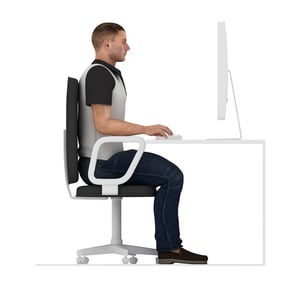 People who work at a computer in an office environment are prone to musculoskeletal disorders (MSDs). Working with the body in a neutral position minimizes that risk by reducing stress on the muscles, tendons, and skeletal system. Let's review proper body mechanics and computer workstation set up.
People who work at a computer in an office environment are prone to musculoskeletal disorders (MSDs). Working with the body in a neutral position minimizes that risk by reducing stress on the muscles, tendons, and skeletal system. Let's review proper body mechanics and computer workstation set up.
Neutral body posture
Here are important considerations to keep in mind each day when attempting to maintain neutral body posture while working at a computer workstation:
- Hands, wrists, and forearms are straight, in-line and roughly parallel to the floor.
- Head is level, forward facing, and balanced. Generally, it’s in line with the torso. Eyes should be at an even level with computer screen.
- Shoulders are relaxed and upper arms hang normally at the side of the body.
- Elbows stay in close to the body and are bent between 90 and 120 degrees.
- Feet are fully supported by the floor or a footrest if the desk height isn’t adjustable.
- Back is fully supported with appropriate lumbar support when sitting vertical or leaning back slightly.
- Thighs and hips are supported and generally parallel to the floor.
- Knees are about the same height as the hips with the feet slightly forward.
Workplace environment tips
Here are some additional tips for creating an optimal workplace environment.
- Arrange offices to reduce glare from overhead lights, desk lamps, and windows to minimize strain on eyes.
- Maintain appropriate air circulation and temperature settings.
- Avoid having desks directly under air conditioning vents or heat blowers that “dump” air directly on top of workers.
- Keep ambient noise to a minimum.
- Support an inclusive and collaborative environment among staff. Every team member should feel valued to avoid stress, staff disengagement, or work-place negativity. These can lead to headaches, physical tension, and discomfort.
Even when the design of the workstation is correct and environmental factors are at their best, users can face risks from repetitive tasks. When motions are isolated and repeated frequently for prolonged periods, there may be inadequate time for muscles and tendons to recover. Combining repetitive tasks with factors such as awkward postures and muscular or joint stress may increase the risk of injury. Additionally, failing to recognize early warning signs could result in the development of serious injuries.
Musculoskeletal Disorder Signs and Symptoms
To prevent serious injury or permanent damage, it’s important to seek assessment from a medical professional for signs and symptoms as early as possible. Users at risk for MSDs associated with computer use may experience some of these signs or symptoms:
- Numbness or a burning sensation in the hand
- Reduced grip strength
- Swelling or stiffness in the joints
- Pain in wrists, forearms, elbows, neck, or back
- Reduced range of motion in the shoulder, neck, or back
- Dry, itchy, or sore eyes
- Blurred or double vision
- Aching or tingling
- Cramping
- Weakness
- Headaches
Get up and move!
Regardless of how good working posture is, working in the same posture or sitting still for prolonged periods isn’t healthy. Everyone should change working position frequently throughout the day by:
- Stretching fingers, hands, arms, and torso;
- Periodically standing up and walking around for a few minutes; and
- Performing some tasks at a stand-up work station.
Source: https://www.osha.gov/SLTC/etools/computerworkstations/workprocess.html





